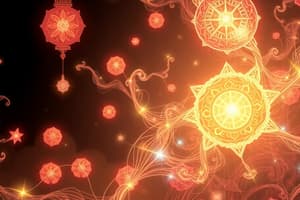Podcast
Questions and Answers
What type of bonding occurs when there is a large electronegativity difference between atoms?
What type of bonding occurs when there is a large electronegativity difference between atoms?
- Metallic bonding
- Ionic bonding (correct)
- Hydrogen bonding
- Covalent bonding
What is an atom called that loses one or more valence electrons?
What is an atom called that loses one or more valence electrons?
- Isotope
- Anion
- Cation (correct)
- Molecule
What is the charge of a sodium ion after losing one electron?
What is the charge of a sodium ion after losing one electron?
- -1
- +2
- 0
- +1 (correct)
Which of the following correctly exemplifies an anion?
Which of the following correctly exemplifies an anion?
What type of ion is formed by gaining electrons?
What type of ion is formed by gaining electrons?
What indicates a positively charged ion?
What indicates a positively charged ion?
What happens to the stability of an atom when it forms an ion?
What happens to the stability of an atom when it forms an ion?
What occurs as a result of ionic bonding between two ions?
What occurs as a result of ionic bonding between two ions?
What type of bond is formed through the electrostatic attraction between positive and negative ions?
What type of bond is formed through the electrostatic attraction between positive and negative ions?
In covalent bonds, what is primarily shared between atoms?
In covalent bonds, what is primarily shared between atoms?
Which factor primarily determines the nature of interactions between atoms in a covalent bond?
Which factor primarily determines the nature of interactions between atoms in a covalent bond?
What type of bond is likely to occur between two nonmetals with different electronegativities?
What type of bond is likely to occur between two nonmetals with different electronegativities?
How do covalent bonds help nonmetals achieve stability?
How do covalent bonds help nonmetals achieve stability?
What describes the electron sharing in a polar covalent bond?
What describes the electron sharing in a polar covalent bond?
When a fluorine atom shares an electron with a carbon atom, how many total valence electrons does fluorine effectively use?
When a fluorine atom shares an electron with a carbon atom, how many total valence electrons does fluorine effectively use?
Which atoms typically form covalent bonds with each other?
Which atoms typically form covalent bonds with each other?
What type of bond is formed when two electrons are shared between two atoms?
What type of bond is formed when two electrons are shared between two atoms?
Which type of bond is characterized by the overlap of atomic orbitals along the orbital axis?
Which type of bond is characterized by the overlap of atomic orbitals along the orbital axis?
How many single bonds does carbon need to form with fluorine atoms to complete its octet?
How many single bonds does carbon need to form with fluorine atoms to complete its octet?
Which type of bond is formed when four electrons are shared between two atoms?
Which type of bond is formed when four electrons are shared between two atoms?
Which type of overlap leads to the formation of a pi bond?
Which type of overlap leads to the formation of a pi bond?
What is a characteristic feature of a coordinate bond?
What is a characteristic feature of a coordinate bond?
Which type of bond is the weakest among the covalent interactions?
Which type of bond is the weakest among the covalent interactions?
How many bonds does a triple bond consist of?
How many bonds does a triple bond consist of?
What type of hybridization is involved in the bonding of acetylene?
What type of hybridization is involved in the bonding of acetylene?
Which statement correctly describes the electrons in the 2p orbitals of acetylene?
Which statement correctly describes the electrons in the 2p orbitals of acetylene?
How does the acidity of sp hybridized molecules compare to sp3 hybridized molecules?
How does the acidity of sp hybridized molecules compare to sp3 hybridized molecules?
What is the bond length of a C≡C bond in acetylene?
What is the bond length of a C≡C bond in acetylene?
What is the relationship between bond type and energy?
What is the relationship between bond type and energy?
What is the main characteristic of electrons found in s orbitals?
What is the main characteristic of electrons found in s orbitals?
Which of the following statements about bond lengths is true?
Which of the following statements about bond lengths is true?
What is the inductive effect primarily associated with?
What is the inductive effect primarily associated with?
Which of the following groups is an electron-withdrawing group?
Which of the following groups is an electron-withdrawing group?
What is the key difference between homolytic and heterolytic fission?
What is the key difference between homolytic and heterolytic fission?
Resonance involves the delocalization of which type of electrons?
Resonance involves the delocalization of which type of electrons?
Which of the following is a characteristic of resonance?
Which of the following is a characteristic of resonance?
What is the result of homolytic bond fission?
What is the result of homolytic bond fission?
Which condition does not apply to the inductive effect?
Which condition does not apply to the inductive effect?
Which of the following statements about heterolytic fission is true?
Which of the following statements about heterolytic fission is true?
Flashcards are hidden until you start studying
Study Notes
Ionic Bonds
- Form between atoms with large electronegativity differences, usually metals and nonmetals.
- Transfer of valence electrons from the metal to the nonmetal.
- Metal atom becomes a positively charged ion (cation) and the nonmetal becomes a negatively charged ion (anion).
- Oppositely charged ions attract each other forming an ionic compound.
Forming an Ion
- Ionic bonds involve the exchange of valence electrons between atoms.
- An atom losing electrons becomes a cation (positively charged).
- An atom gaining electrons becomes an anion (negatively charged).
- The ion is more stable than the atom due to the octet rule.
Forming an Ionic Bond
- Oppositely charged ions attract each other due to electrostatic forces.
- Large electronegativity differences cause an unequal sharing of electrons, resulting in complete electron transfer.
Types of Chemical Bonds
- Ionic Bond: results from the electrostatic attraction between positively and negatively charged ions.
- Covalent Bond: formed by the sharing of valence electrons between atoms.
- Coordinate Bond (also called a dative covalent bond or dipolar bond): a type of covalent bond where both electrons in the bond pair come from the same atom.
Covalent Bonds
- Form between atoms with similar or equal electronegativity.
- Valence electrons are shared between the atoms.
- Electron density is equally distributed between the atoms due to attraction to both nuclei.
- Occur most frequently between two nonmetals.
Polar Covalent Bonds
- Occur when there is a larger electronegativity difference compared to covalent bonds.
- Electrons are still shared but not equally.
- Electrons tend to be closer to the more electronegative atom.
- Common between nonmetals.
Forming Covalent Bonds
- Sharing of valence electrons between nonmetals to satisfy the octet rule.
- Sharing two electrons is a "single bond".
- Covalent bonds require specific orientation of atoms for overlap of bonding orbitals.
Types of Covalent Bond Interactions
- Sigma (σ) bonding: strongest, formed by the overlap of atomic orbitals along the orbital axis.
- Pi (π) bonding: weaker, formed by the overlap of two lobes of atomic orbitals above and below the orbital axis.
Covalent Bond Multiplicity
- Single bond: sharing of two electrons, one sigma bond.
- Double bond: sharing of four electrons, one sigma and one pi bond.
- Triple bond: sharing of six electrons, one sigma and two pi bonds.
Electronic Configuration
- s orbitals: spherical.
- p orbitals: dumbbell-shape.
- Overlap can occur in various ways:
- s and s overlap: forms a sigma bond.
- s and p overlap: forms a sigma bond.
- p and p overlap:
- Head-on overlap: forms a sigma bond.
- Sidewise overlap: forms a pi bond.
Effect of Hybridization on Bond Length and Acidity
- Hybridization: mixing of atomic orbitals to form hybrid orbitals.
- Increased s character:
- Stronger attraction of electrons to the nucleus.
- Shorter bond lengths.
- Increased acidity.
Bond Length and Bond Energy
- Bond length: average distance between the centers of two bonded atoms.
- Bond energy: energy needed to break a bond into individual atoms.
- In general:
- Triple bonds: strongest, shortest bond length.
- Double bonds: intermediate strength and length.
- Single bonds: weakest, longest bond length.
Factors Affecting Electron Availability at an Atom
- Inductive effect: electron-withdrawing or donating groups affect electron density at an atom.
- Resonance: delocalization of pi electrons or lone pairs in a planar system with parallel p orbitals.
- Hyperconjugation: interaction of C−H bonds with an adjacent empty or partially-filled p-orbital.
Breaking a Covalent Bond
- Homolytic fission: bond breaks symmetrically with each atom receiving one electron, resulting in free radicals.
- Heterolytic fission: bond breaks asymmetrically with one atom receiving both electrons, resulting in ions.
Studying That Suits You
Use AI to generate personalized quizzes and flashcards to suit your learning preferences.




